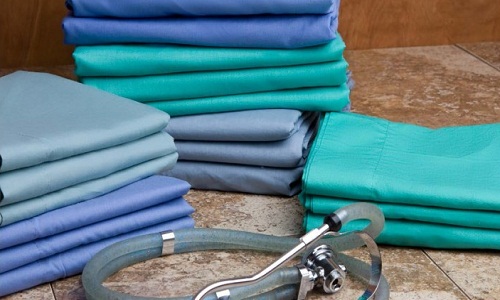FW
Pakistan’s cotton output dropped 33.41 per cent during this season upto February. Heavy rains and pest attacks wreaked havoc with the crop. Cotton production, a mainstay of the country’s textile sector, has been declining for the past few years due to extreme weather conditions, inappropriate policies, shrinking domestic demand and the fluctuation in international cotton prices.
The pace of cotton arrivals at ginning factories also remained slow. Heavy rains in July 2015 inundated a large area of crops of rice and cotton. Low cotton prices, in the previous season, also discouraged farmers from sowing the commodity. Some farmers used their lands for other crops, like maize, fodder, vegetables due to softening domestic cotton prices.
Large areas of the cotton belt in Pakistan have been taken over by sugar mills. Cotton accounts for a 28 per cent share in major crops. The cotton crop for the current fiscal year is estimated at 10.9 million bales, falling well below the target of 15.4 million bales.
Much better yields and production for financial year ’16 are possible if growers are provided free cotton seeds and cotton is bought from them at international prices. In international markets, a slowdown in demand from China is likely to keep cotton prices low despite a fall in global cotton production.
Cambodia exported $7.1 billion worth of apparels and shoes in 2015, up 14.5 per cent from the previous year. Cambodia’s garment and footwear exports grew by 12.7 per cent in the first half of 2015. This increase occurred despite the 28 per cent monthly minimum wage hike that came into effect more than a year ago. The country’s share of the dollar value of US imports rose by 0.1 per cent in the first 11 months of 2015 to 2.9 per cent compared to the year-ago period.
In fact air cargo to and from Cambodia jumped 14 per cent last year, driven by an increase in apparel exports to the US, Japan and China. Most of Cambodia’s exports are garment products and most of its imports are accessories for garment production.
After manufacturing, finished product are sent mostly to the EU and US because these markets provide a quota to Cambodia. However, time will tell if Cambodia can retain its grip on garment exports: minimum wage for textiles and footwear workers went up 9.4 per cent in January, which could cause clothing giants to take their business to other low-cost countries. And air freight growth may slow in 2016 because of global economic uncertainty.
India’s cotton production is likely to decline by over 14 per cent to a five-year low in 2015-16. One reason is a decline in yield of the standing crop in north India. Farmer suicides in states like Andhra Pradesh, Telengana and Maharashtra made for a tragic picture.
Cotton sowing started weak this year on low soil moisture following deficient monsoon rainfall. The overall acreage has declined to 11.76 million hectares from 13.08 million hectares a year ago. The 15 per cent decline in average acreage in Karnataka, Andhra Pradesh, Telengana, Gujarat and Maharashtra is likely to hit farmers.
Unlike last season, when one or two spells of rainfall supported flowering, development and maturing of pods, the lack of winter showers has hit cotton yields now.
In Karnataka the cotton output is estimated at about 1.8 million bales, down from three million bales last year. Whitefly infestation in Punjab and Haryana is set to reduce output of this region to 4.05 million bales from 5.2 million bales in the previous year. The output in Gujarat is also likely to slump to about 9.5 million bales this year from 12.2 million bales a year ago.
There are allegations the yield in some states has been impacted because of spurious seeds supplied to farmers.
Syria's textile industry, once one of the country's bright spots, with its products coveted throughout the region and beyond is in shambles today. The sector has been devastated by the war that erupted in March 2011, with factories destroyed, workers displaced and sanctions hampering trade. The migrant crisis and outflow to Europe have also depleted its workforce.
Before Syria's conflict began, textiles represented some 63 per cent of the industrial sector's total production. According to the Syrian Economic Forum think-tank, the sector was worth 12 per cent of GDP, employed a fifth of the workforce and exports netted around $3.3 billion a year.But by 2014, private sector textile exports had fallen by half, with the industry particularly affected by fighting in Aleppo city, the country's former commercial hub and home to many textile factories.
Nearly 70 per cent of factories were closed or destroyed by the war. In addition, many businesses lost machines and employees. When the war arrived in Aleppo in mid-2012, eventually dividing the city between government control in the west and rebel control in the east, some businesses relocated to small workshops in the city's safer areas.
For all its challenges, Syria's textile industry continues to enjoy a reputation of quality in the region, and the recently concluded Beirut Fair attracted some 500 buyers, mostly from the Middle East.
The rising costs of production, difficult trading environment and shrinking workforce, all mean competitors from Turkey and China are increasingly able to pinch clients from Syria's textile industry. Manufacturers blame shrinking exports in part on sanctions slapped on Syria after the government began its crackdown on dissent following anti-government protests five years ago.
The US alone generates an estimated 24 billion pounds of post-consumer textile waste (PCTW) — the equivalent of about 70 pounds of textiles per person, which ends up in landfills each year according to the Environmental Protection Agency. Major apparel brands such as H&M and The North Face are working to help minimize textile waste through take-back programs, campaigns and collections made from recycled fabrics, while enterprising startups and even the European Union are creating circular processes and economic models.
The solutions presented by the five winners of the first-ever , a €1 million challenge for early-stage innovation in the fashion industry adds to the list of ideas. Introduced in August by the non-profit H&M Conscious Foundation, the goal of the Award is to catalyze bold, pioneering ideas to help protect the planet by closing the loop for fashion.
The first five winning ideas range from creating new textiles out of citrus juice by-products and an online marketplace for recycling of textile leftovers to using microbes to recycle waste polyester. Now, the global public is asked to allocate the €1 million grant between the winners in an online vote this week.
Over 2,700 innovators from 112 countries shared their ideas to help close the loop for fashion. The winning innovations are important contributions in the journey towards a circular fashion industry. Now, the foundation has invited the public to use their voice and influence how much funding each idea should get, said H&M CEO Karl-Johan Persson, also a board member of the H&M Conscious Foundation.
Public votes for their favorite innovations will determine distribution of the €1,000,000 grant. The idea that gets the most votes receives €300,000, second most votes receives €250,000 and third, fourth and fifth most votes receive €150,000 each. Everyone can vote atglobalchangeaward.com, February 1-7. The voting result and the people behind the winning innovations will be revealed at a grand award ceremony in Stockholm, February 10, and on globalchangeaward.com on February 11.
The 78th edition of Pitti Filati that took place on Florence, Italy from January 27 to 29, got a huge response. Final attendance figures show a two per cent increase in the number of buyers with compared to last year, bringing the total to 4.250. The number of foreign buyers exceeded 1,800, slightly more than last year. The number of companies from Japan was up five per cent. There was a great rebound comeback from Russia with the number of buyers up 50 per cent. China, Hong Kong and Turkey also maintained good turnouts. “This has been a definitely positive and energetic edition of Pitti Filati. Our exhibitors confirmed not only excellent results in terms of attendance, but also huge satisfaction for the high quality of the visitors which translated into three intense days of work at the stands with orders and samples for next season booked by designers and representatives from the style bureaus of the world’s major names in fashion,” said Raffaello Napoleone, Pitti Immagine CEO
The Italian market enjoyed a 3.5 per cent increase – an excellent result for the entire industry after a few seasons with low numbers of Italian buyers. Exhibitors confirmed not only excellent results in terms of attendance but also huge satisfaction for the high quality of the visitors which translated into three intense days of work at the stands with orders and samples for the next season booked by designers and representatives from the style bureaus of the world’s major names in fashion.
Pitti Filati revolved around the high end of the market. The event gives the yarn industry great hopes for this year. A section that launched trends and provided inspiration for knitwear research got a great response.
www.pittimmagine.com/en/corporate/fairs/filati.html
US manufacturing activity contracted in January for a fourth straight month. Factories grappled with a strong dollar and lower oil prices forced energy firms to further cut spending, but the pace of the decline appeared to be slowing. Consumer spending was flat in December, but a jump in savings to a three-year high offered hope that consumption would rebound in the coming months.
The buoyant dollar has combined with tepid global demand to undermine US exports. At the same time, businesses are working to reduce a huge pile of unsold merchandise that’s clogging warehouses, which has left little scope to place new orders with factories.
But there are rays of hope for the sector, which accounts for 12 per cent of the economy. Last month, more factories reported an increase in orders and production. In addition, inventory levels and order books appeared to be stabilising. Consumer spending was unchanged in December after increasing 0.5 per cent in November. Spending on long-lasting manufactured goods such as autos dropped 0.9 per cent. Purchases of nondurable goods, including apparel, also fell 0.9 per cent.
Consumer spending, which accounts for more than two-thirds of US economic activity, increased 3.4 per cent in 2015 after advancing 4.2 per cent in 2014.
"Acton points out, every time there are new technologies or new additives in the linen, they don’t really consider, for example, the flatwork department. Sometimes it’s just trial and error to deal with some of the issues that arise. Mangini recommended developing a close working relationship with vendors before a high-tech linen product gets into a healthcare system. Testing brings up another area that was discussed by the panel: Do high-tech healthcare linen really work? The panelist felt, testing hasn’t been done yet."

Linen processing in the healthcare industry is changing. The sheets, gowns and other products used by healthcare facilities were all once made from traditional fibers. Today, those fibers are going high-tech. Vendors are creating linen with antimicrobial properties using a variety of processes and materials to help combat hospital-acquired/associated infections (HAI).
Linen innovations in healthcare textiles

The industry however is just in the initial stages of this new technology, and there are several factors that healthcare facilities and laundries need to consider before investing in these new linens.
These considerations were discussed at a panel at the recent ‘Clean Show’ during an educational session titled Going Hi-Tech: Emerging Textile Technologies. The panel included: James Mangini, Director of Linen Services at Maine Medical Center, Ty Acton, Global Sales VP, Tingue, Brown & Co, Fontaine Sands, Associate Professor at Eastern Kentucky University, Joe Scully, President, In Textiles LLC and Doug Story, VP Corporate Support, Gurtler Industries.
According to Scully, from a textile manufacturer’s point of view, the proper antimicrobial technology is the “holy grail. He says that there are many different types of technology out there, but he thinks the ‘holy grail’ has been found yet. There are two types of applications of antimicrobials to textiles, in the manufacturing process. Scully says that one is inherent, wherein the antimicrobial agent is introduced into the synthetic polymer prior to the extrusion of the fiber. The antimicrobial agents last longer on the inherent side, typically, but it is more expensive. Scully says that the cost of production with the chemical used on the linen could be an additional 20-30 per cent.

Acton points out, every time there are new technologies or new additives in the linen, they don’t really consider, for example, the flatwork department. Sometimes it’s just trial and error to deal with some of the issues that arise. Mangini recommended developing a close working relationship with vendors before a high-tech linen product gets into a healthcare system. Testing brings up another area that was discussed by the panel: Do high-tech healthcare linen really work? The panelist felt, testing hasn’t been done yet.
Story said the EPA (Environmental Protection Agency) has not certified antibacterial products to specific microorganisms. The EPA does look at processes, however, according to Story. In terms of approval, the EPA goes into a plant and asks for the validation of the processes of creating hygienically sanitized or sterile areas. Story pointed out, the EPA wants to be able to follow a piece of material through a plant and, when it comes out the other end and is delivered to the healthcare facility, know that it’s going to be just as clean as it was when it was brand-new or the last time it was washed and certified.
When it comes to hygienically clean linen processes, Sands suggested looking at the plant before looking at the linen. Looking at a laundry’s system, Sands says there are certain things that can be controlled. These include water quality and temperature, amount of agitation, proper loading, the appropriate amount of time and chemicals, and the heat/temperature.
A textile and garment machinery fair will be held in Bangladesh, February 4 to 7, 2016. The fair will offer a platform for local exporters to interact with manufacturers, regional agents and wholesalers and source high-quality machinery, equipment and materials.
Over 1,000 machinery makers from 33 countries, including Bangladesh, will display a wide variety of state-of-the-art textile and garment technology, machinery and parts. Exhibitors, through 1,160 booths, will showcase the latest machines and technology to textile and industry people, including spinners, weavers and knitters. Countries like Australia, China, Hong Kong, Turkey, UK, UAE, USA, France, Germany, South Korea, India, Pakistan and Vietnam will be present. Global brands like Jakob Muller, Karl Mayer, Picanol, Rieter, Santoni, Shima Seiki will display and sell their products.
Bangladesh’s imports of textile machinery in the fiscal year of 2014-15 went up by over 40 per cent compared to the last fiscal year of 2013-14. More than 1,300 spinning, weaving, dyeing, printing and finishing mills in the country have invested four billion dollars and the sector’s contribution to the gross domestic product amounts to 13 per cent.
This sector has established a strong backward linkage industry for the country’s garment sector. As a result, the garment sector has been able to keep up its growth momentum and remain sustainable.
The Kooples has chosen to use Lectra’s patternmaking, grading and prototyping solution for support in its expansion plans. The Kooples was a brand founded in France in 2008. Its accessible high-end product positioning and an identity centered on the concept of fashion for men and women have set it apart from competitors. The brand controls its entire supply chain, from design to distribution. Its priorities are now to widen its product range by introducing sportswear and children’s wear as well as to expand business internationally, particularly in Europe and the United States.
Its philosophy focuses on reworking the British art of bespoke tailoring, offering contemporary and effortlessly cool silhouettes. It does away with the traditional notion of separate men’s and women’s clothing and creates concepts which fuse and mingle the collections.
The embodiment of a pioneering spirit, The Kooples consistently breaks new ground and has extended its ready-to-wear expertise to include shoes, accessories and watches. Its minimalist design and unique fit are immediately recognizable.
The Lectra solution allows product development department to perfect its patternmaking process and the company to expand its collections without growing its team. The company can also boost its responsiveness at the product development stage without sacrificing the quality of its clothing.
www.thekooples.com/












